13.10.2005
K. Sakaev SAN LUIS OPENING LABYRINTHS Part 2
B92 Morozevich-Kasimdzhanov, round 1
1.e4 c5 2.¤f3 d6 3.d4 cxd4 4.¤xd4 ¤f6 5.¤c3 a6 6.Ґe2 e5 7.¤b3 Ґe7 8.0–0 0–0 9.ўh1 ¤c6 10.f3
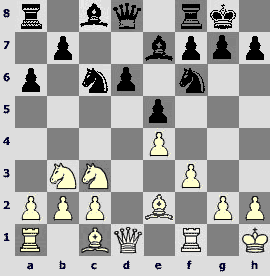
10...b5?! Black himself creates a target for attack, and in ends up in a position without active play. Main theoretical debate goes around 10...Ґe6 11.¤d5 a5!?
11.Ґe3 ¤a5 12.¤xa5 Јxa5 13.Јd2 Јc7
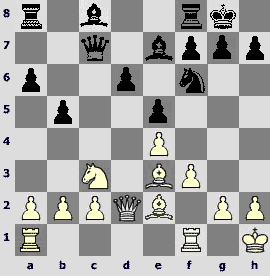
Continuing 14.¦fc1!±, White was preparing a more favorable version of the a2-a4 break, which could have created more serious problems. But Sasha Morozevich hastened a bit:
14.a4 b4 15.¤d5 ¤xd5 16.exd5 Ґf5. 16...Јa5 17.¦fc1 Ґd7!? 18.c3 bxc3 19.¦xc3 Ґf6 deserved attention, and Black is close to equality. 16...a5 is also possible.
17.¦fc1 Јa5 18.c4 bxc3 19.¦xc3 with slight White's advantage.
B92 Adams-Kasimdzhanov, round 5
1.e4 c5 2.¤f3 d6 3.d4 cxd4 4.¤xd4 ¤f6 5.¤c3 a6 6.Ґe2 e5 7.¤b3 Ґe7 8.0–0 0–0 9.ўh1 Ґd7
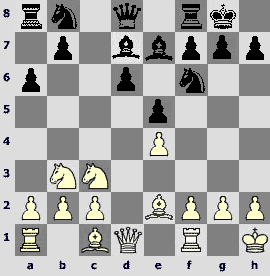
In his game with Adams Kasimdzhanov tries the way to deviate from the main line that is different from the one in the game with Morozevich 10.Ґg5!? [more usual choice is 10.Ґe3 Ґc6 11.f3 with slight advantage] 10...Ґc6 11.Ґxf6 Ґxf6 12.Ґc4 Ґe7 13.Јe2 ¤d7 14.¦fd1 ўh8 15.¤d2 ¤f6 16.a4 g6 17.Ґb3 Јc7 18.a5 ¦ad8 19.¤f1 ¤h5 20.¤e3 Ґg5 21.¤ed5 Јb8І
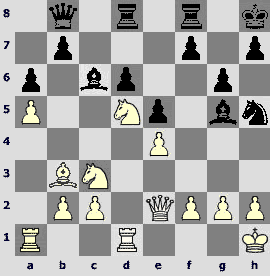
The b8-square is a poor spot for the queen, White has a better position.
B48 Leko-Polgar, round 4
1.e4 c5 2.¤f3 e6 3.d4 cxd4 4.¤xd4 ¤c6 5.¤c3 Јc7 6.Ґe3 a6 7.Јd2 ¤f6 8.0–0–0 Ґb4 9.f3 ¤e7 10.¤de2 b5 11.g4 h6
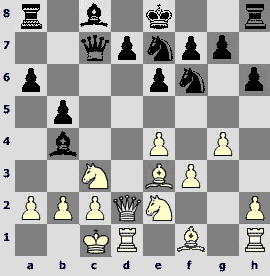
12.¦g1N. White's idea is to bring the rook into play via g5: 12.h4 Ґa5 13.a3 b4 14.axb4 Ґxb4 15.Ґh3 Јa5 16.ўb1 d6 with unclear play (Naiditsch – Nisipeanu, Warsaw 2005); 12.a3 Ґa5 13.b4 Ґb6 14.Ґxb6 Јxb6 15.¤d4 is also interesting (L'ami-Van der Elburg, Amsterdam 2005). Subsequently Black had to plan the e6-e5 advance followed by d7-d5, even if this demands a pawn sacrifice.
12...¤g6 [12...Ґa5 is more natural] 13.a3 Ґe7?! [and here one had to think about 13...Ґa5, not allowing f3-f4] 14.f4 b4?! [14...d6 is better] 15.axb4 Ґxb4 16.Јd4 Јa5 17.ўb1ќ
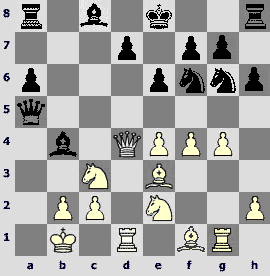
The knight had come on g6 by mistake; there is no satisfactory defense against g4-g5.
C42 Leko-Adams, round 7
1.e4 e5 2.¤f3 ¤f6 3.¤xe5 d6 4.¤f3 ¤xe4 5.d4 d5 6.Ґd3 ¤c6 7.0–0 Ґe7 8.c4 ¤b4 9.Ґe2 0–0 10.a3 ¤c6 11.cxd5 Јxd5 12.¤c3 ¤xc3 13.bxc3 ¤a5?!
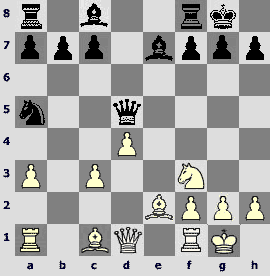
In any Pioneers Palace or DYuSSh(Junior sports school) one was formerly taught that at first one has to finish the development, and then make various maneuvers and pawn breaks... The absence of Soviet chess schooling is obvious; poor English gentleman has to study nuts and bolts of chess theory on practice... And speaking seriously, I think that a regular 13...Ґf5 is really stronger.
14.¤e5! The knight rushes where it was invited.
The transfer of any rook to the half-open file looks weaker, for example 14.¦b1?! In future the rook gets under attack here: 14...a6 (14...c6 is also quite possible) 15.¤e5 Ґf5 16.Ґf3 Јe6 (16...Ґe4 also looks effective) 17.¦b2 Ґxa3 18.¦e2 Ґxc1 19.¤c6 Јf6 20.¤xa5 Ґf4 21.¤xb7 ¦ab8 – the pieces activity compensates the deficiencies of Black's pawn structure (Svidler-Adams, round 1).
14.¦e1 Ґd6! Denying the knight of the e5 square. 15.¦b1?! Ґd7 16.Ґe3?! (16.¤e5 Ґxe5 17.dxe5 Јxd1 18.¦xd1 Ґe6 with probable equality) 16...¤c4! 17.¤d2 ¤xe3 18.fxe3 Јg5 19.Ґf3 ¦ae8 20.¤c4 b6 21.e4 Ґf4 22.Јc2 ¦e6, developing the kingside initiative (Polgar-Adams, Sofia 2005).
14...Ґf5?! Black does not say «B» after having said «A». 14...c5 was a logical continuation of the plan that began on the previous move. The hybrid of two plans turns out to be absolutely unsuccessful.
15.c4! Black took the tension off the center, and white pawns can move freely.
15...Јd6 16.c5! Јd5. It is due to the miscalculation, 16...Јe6 was anyway better.

17.Ґf3 Ґe4 18.Ґxe4 Јxe4 19.Ґd2! ¤c6 [19...Јxd4 20.¤f3 Јxc5 21.Ґb4ќ] 20.¦e1 Јh4 21.¤f3 Јh5 22.¦b1 Ґf6. Black cannot protect the queenside pawns – 22...b6 23.cxb6 cxb6 24.¦c1ќor 22...¦ab8 23.Ґf4ќ.
23.¦xb7 ¤xd4 24.¤xd4 Јxd1 25.¦xd1 Ґxd4 26.Ґe3 Ґxe3 27.fxe3ќ
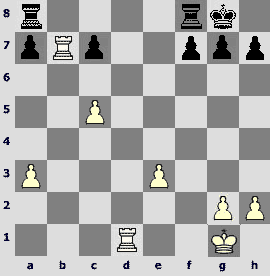
Ending is won for White because of the active rooks' position and future passed c-pawn.
C89 Anand-Svidler, round 6
1.e4 e5 2.¤f3 ¤c6 3.Ґb5 a6 4.Ґa4 ¤f6 5.0–0 Ґe7 6.¦e1 b5 7.Ґb3 0–0 8.c3 d5 9.exd5 ¤xd5 10.¤xe5 ¤xe5 11.¦xe5 c6 12.d4 Ґd6 13.¦e1 Јh4 14.g3 Јh3 15.¦e4 g5 16.Јf1 Јxf1+ 17.ўxf1 Ґf5 18.f3 h6
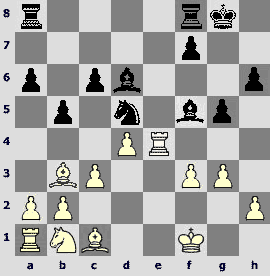
19.¤d2N. A logical novelty. 19.¦e1 ¦fe8 20.Ґxd5 cxd5 21.¦xe8+ ¦xe8 22.ўf2 a5 23.a3 Ґd3 leads to the simple equality (1/2–1/2 Peng Xiaomin-Grischuk, Shanghai 2001), for example 24.Ґe3 f5 25.f4 a4 26.¤d2 g4 etc.
19...Ґxe4!? Another possibility is 19...¤f6, but the text move is more principled: Black takes the exchange immediately and then tries to open files for his rooks at all costs.
20.fxe4 ¤c7 21.ўg2?! 21.e5 creates a target for attack – 21...Ґe7 22.¤e4 ¤d5, and then f7-f6. I think the strongest move was 21.¤f3!, and if 21...c5, then 22.Ґe3! White does not advance the pawn centre, but tries to fortify it at most.
21...c5 22.e5 Ґe7 23.¤e4 cxd4 24.cxd4 a5=
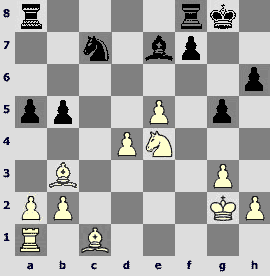
White's centre is unstable, Black has a good play.
C88 Topalov-Kasimdzhanov, round 7
1.e4 e5 2.¤f3 ¤c6 3.Ґb5 a6 4.Ґa4 ¤f6 5.0–0 Ґe7 6.¦e1 b5 7.Ґb3 0–0 8.h3 Ґb7 9.d3 d6 10.a3 ¤a5 11.Ґa2 c5 12.¤bd2 ¤c6 13.¤f1 Ґc8 14.c3 Ґe6 15.Ґxe6 fxe6 16.b4
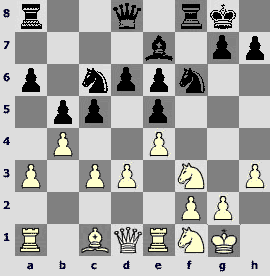
16...Јd7N. 16...¤h5?!, that was played earlier looks like «a wrong direction»: 17.¤1h2 ¤f4 18.Ґxf4 ¦xf4 19.Јb3 Јd7 20.a4 bxa4 21.¦xa4 cxb4 22.cxb4 ¦b8 23.¦ea1 – Black has a very unpleasant position (Adams-Kasimdzhanov, Linares 2005).
17.Јb3 ¦fb8!? 18.¤1h2 a5 19.Ґd2 h6 (useful prophylaxis) 20.¤g4
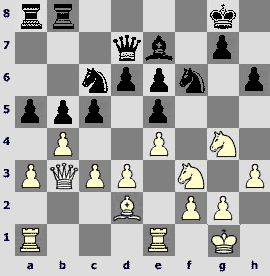
Now 20...axb4, recommended by Sergey Shipov, is probably best (20...¤xg4?!, which happened in the game, strengthens White's pawn structure; Black's position after that is very difficult) 21.axb4 cxb4 22.cxb4 ¤h7І. Black transfers the knight to f8, releasing the queen from protecting the e6-pawn. In this case White's advantage is minimal.
C88 Svidler-Leko, round 3
1.e4 e5 2.¤f3 ¤c6 3.Ґb5 a6 4.Ґa4 ¤f6 5.0–0 Ґe7 6.¦e1 b5 7.Ґb3 0–0 8.h3 Ґb7 9.d3 ¦e8 10.a4 h6 11.¤c3 b4 12.¤d5
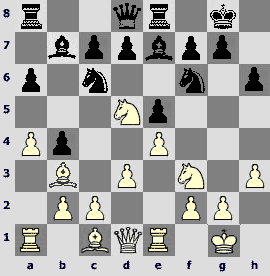
12...¤a5N. Earlier there was 12...Ґc5 13.a5 ¦b8 14.Ґe3 Ґxe3 15.fxe3 ¤xd5 16.Ґxd5 d6 17.¦f1 1/2–1/2 (Grischuk-Tkachiev, Delhi 2000). I suppose that White could have continued the struggle.
13.Ґa2 Ґc5. Dubious is 13...b3?! 14.¤xe7+ ¦xe7 15.cxb3 ¤c6 (15...c5 16.b4 cxb4 17.Ґd2±) 16.Ґd2 a5 17.¦c1±.
14.Ґd2! «Looking» at the knight that rests on a5.
14...Ґxd5 15.Ґxd5 ¤xd5 16.exd5
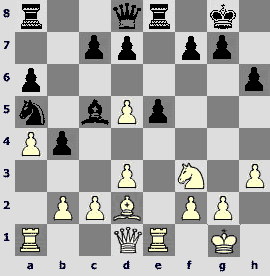
16...Јf6? The variation assessment depends on 16...c6!, rescuing the knight from a5 as soon as possible. After 17.¦xe5 ¦xe5 18.¤xe5 Јf6 19.¤f3 cxd5 20.c3 White's advantage is minimal.
17.c3 bxc3?! 17...Јb6 is better, but even here after 18.Ґe3 Ґxe3 19.¦xe3 d6 20.¤h4 White has dangerous initiative.
18.Ґxc3 Јb6 19.¦xe5 Ґxf2+ 20.ўh1±
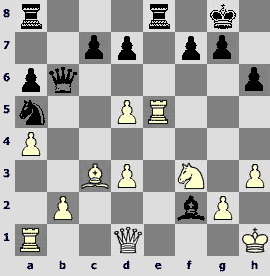
The difference of minor pieces locations is obvious; White has a serious advantage.
C92 Anand-Adams, round 3
1.e4 e5 2.¤f3 ¤c6 3.Ґb5 a6 4.Ґa4 ¤f6 5.0–0 Ґe7 6.¦e1 b5 7.Ґb3 d6 8.c3 0–0 9.h3 Ґb7 10.d4 ¦e8 11.¤bd2 Ґf8 12.a4 h6 13.Ґc2 exd4 14.cxd4 ¤b4 15.Ґb1 c5 16.d5 ¤d7 17.¦a3 c4 18.axb5 axb5 19.¤d4 Јb6 20.¤f5 ¤e5 21.¦g3 g6 22.¤f3 ¤ed3
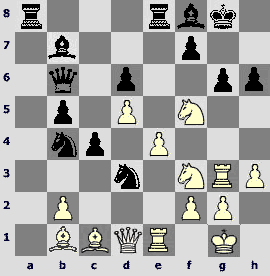
23.Јd2!!N Everything is very simple – a queen is going to have a date with black king, and other pieces help her a bit. It is amazing, how not the weakest players allow such positions with a light heart. Previously only 23.Ґe3 was played.
23...Ґxd5 [23...¤xe1 24.¤xe1, keeping all the threats] 24.¤xh6+ Ґxh6 25.Јxh6 Јxf2+ 26.ўh2 ¤xe1 [26...Ґxe4 27.¤g5 ¤xe1 28.Ґxe4ќ; 26...¤xc1 27.exd5 ¤cd3 28.¦e6ќ] 27.¤h4 ¤ed3 28.¤xg6 Јxg3+ 29.ўxg3 fxg6 30.Јxg6+ ўf8 31.Јf6+ ўg8 32.Ґh6 1–0
E15 Topalov-Anand, round 2
1.d4 ¤f6 2.c4 e6 3.¤f3 b6 4.g3 Ґa6 5.b3 Ґb4+ 6.Ґd2 Ґe7 7.Ґg2 c6 8.Ґc3 d5 9.¤e5 ¤fd7 10.¤xd7 ¤xd7 11.¤d2 0–0 12.0–0 ¦c8 13.e4 c5 14.exd5 exd5 15.dxc5 dxc4 16.c6 cxb3 17.¦e1 b2 18.Ґxb2 ¤c5 19.¤c4 Ґxc4 20.Јg4 Ґg5 21.Јxc4 ¤d3 22.Ґa3 ¤xe1 23.¦xe1 ¦e8
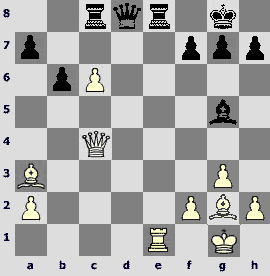
This is all theory. Previously White were playing 24.Ґe4 here. White's wish to save rooks is understandable, but he does not want to place himself under the pin.
24.¦xe8+N 24...Јxe8 25.Ґd5=. White has enough compensation for exchange, but with both opponents playing well, the game will end in a draw. However, Topalov made Anand to worry a bit by his utmost inventive and insistent play.
It is amazing that during the first half only the Topalov-Anand game was interesting amongst closed games, but even this one was interesting more because of the middlegame and not the opening. We will see whether this tendency will change in the second half, after which we will sum up the championship.
